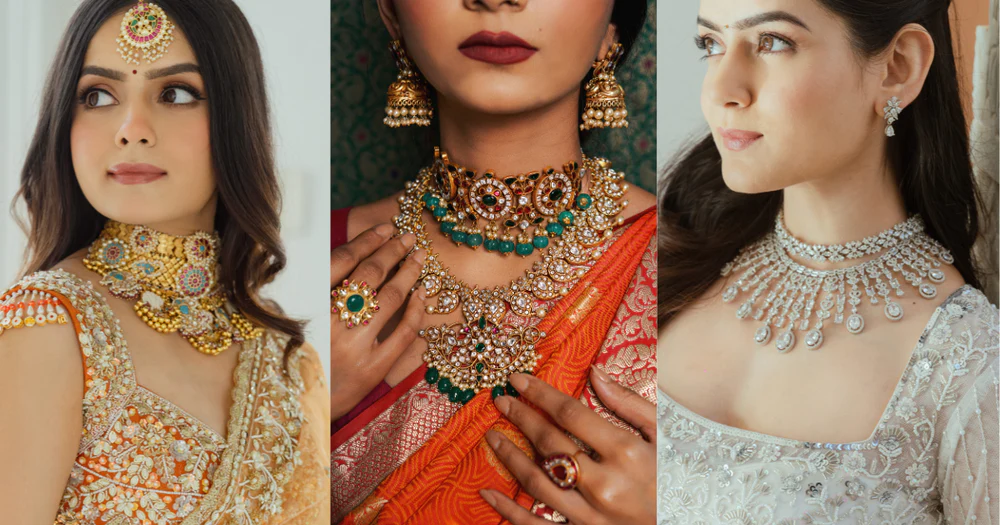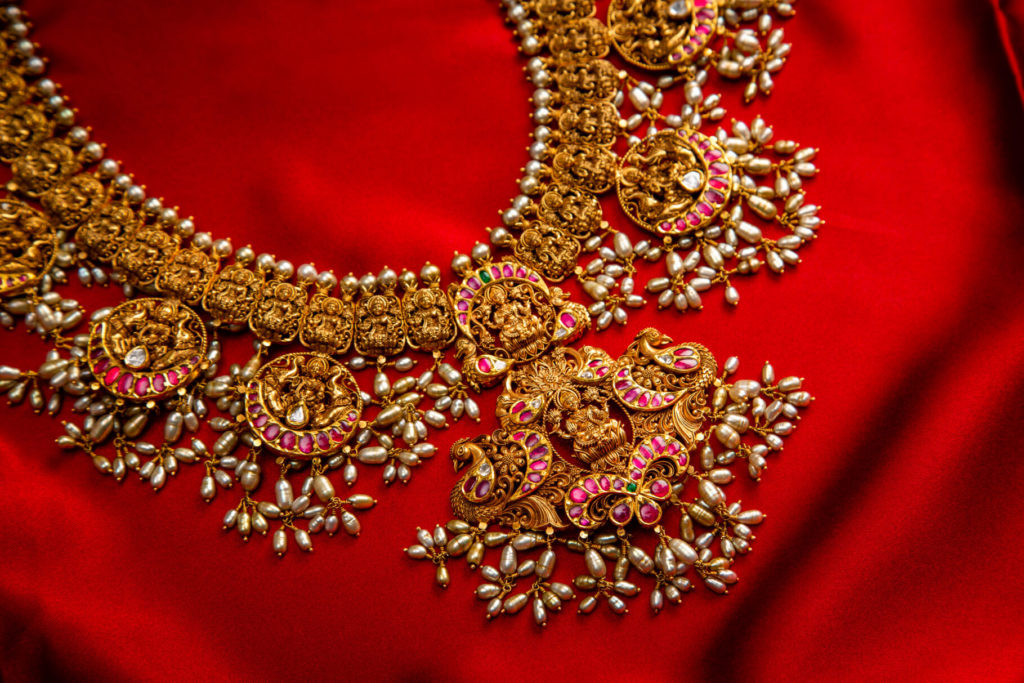Introduction
India’s relationship with jewellery is deep-rooted and timeless. Across centuries, traditional Indian jewellery has served as more than just decorative adornment—it has reflected cultural values, regional identity, religious beliefs, and a rich legacy of artistry. Passed down through generations, traditional Indian jewellery tells stories of royalty, mythology, and craftsmanship that still echo in modern-day celebrations and ceremonies.
In this blog, we’ll explore the diverse world of traditional Indian jewellery, its regional varieties, symbolic significance, and why it remains a treasured part of Indian culture today.
Tradition and Belief in Indian Jewellery

In India, jewellery is not merely an accessory—it’s an integral part of a person’s identity, especially in rites of passage like weddings, childbirth, and festivals.
- Symbol of Prosperity: Gold, in particular, is considered auspicious and a sign of wealth and blessings.
- Spiritual Protection: Many pieces, like mangalsutras and nose rings, are worn for protection and to ward off evil.
- Marital Status: Jewellery often reflects life stages—especially marital ones. For example, bangles, toe rings, and sindoor signify that a woman is married.
- Expression of Tradition: Each piece, whether subtle or ornate, connects the wearer to age-old customs and regional heritage.
Traditional Indian Jewellery
Indian traditional jewellery showcases diverse designs and rich symbolism that vary across regions. Here are some iconic pieces and their meanings:
1. Maang Tikka
Worn on the forehead, the maang tikka symbolizes the third eye or spiritual wisdom. It’s a staple in bridal wear, representing unity of the feminine and masculine energies.
2. Nath (Nose Ring)
People believe this traditional ornament enhances a woman’s beauty and, according to Ayurveda, supports reproductive health. Women commonly wear it during weddings and festivals.
3. Jhumkas (Bell-Shaped Earrings)
Timeless and graceful, jhumkas represent femininity and rhythm, often paired with classical attire for festive or religious occasions.
4. Choker and Haar (Necklaces)
From the short, tight choker to the long haar, Indian necklaces come in layered styles, symbolizing wealth, power, and divine energy.
5. Bajubandh (Armlet)
Once worn by kings and warriors, armlets represent strength and protection. Women wear them on festive occasions for grace and tradition.
6. Kamarbandh (Waist Belt)
A decorative belt tied around the waist, especially by brides. It enhances the silhouette and symbolizes fertility and marital status.
7. Payal and Bichua (Anklets and Toe Rings)
Common in many Indian households, especially in the south, these pieces symbolize marriage, balance, and devotion.
8. Mangalsutra
This sacred thread worn by married women is a symbol of marital unity and longevity of the husband’s life, typically made of gold and black beads.
Regional Styles of Indian Jewellery
India’s cultural diversity is reflected in the vast range of regional jewellery styles, each with its own history, techniques, and materials.
1. Kundan and Polki (Rajasthan and Gujarat)
Known for their intricate gold work and uncut diamonds, these styles are regal, ornate, and were once exclusive to royalty.
2. Meenakari (Rajasthan)
This is the art of colorful enamel painting on metal. It adds vivid hues and charm to necklaces, earrings, and bangles.
3. Temple Jewellery (Tamil Nadu and Kerala)
Inspired by temple deities and architecture, this type of jewellery is made in gold with intricate motifs of gods and goddesses, traditionally worn by classical dancers and brides.
4. Tribal Jewellery (Madhya Pradesh, Odisha, Northeast)
Rustic and bold, tribal jewellery often uses oxidized silver, beads, shells, and natural materials. It reflects raw energy and connection to nature.
5. Gold Jewellery of Bengal and Assam
Bengali jewellery features filigree gold work, while Assamese designs like the Loka-paro (twin bird motifs) blend beauty with symbolism
Timeless Craftsmanship and Materials
Skilled artisans handcraft Indian traditional jewellery using techniques passed down through generations.
- Kundan setting involves placing stones in gold foil.
- Jadau is a Mughal-era technique where gems are embedded in gold without soldering.
- Filigree work involves curling fine threads of gold or silver into lace-like patterns.
Common materials include:
- Gold and Silver: For purity, status, and spiritual power.
- Gemstones: Like rubies, emeralds, pearls, sapphires, and diamonds.
- Lac and Glass: In traditional bangles and tribal adornments.
- Black Beads and Coral: For warding off evil.
Traditional Jewellery in Modern Times
Despite modern jewellery trends and fast fashion, traditional Indian jewellery continues to hold its ground—and even thrive.
Why?
- Weddings and Rituals: No Indian wedding is complete without heirloom-worthy traditional jewellery.
- Revived Fashion Trends: Designers now blend traditional motifs with contemporary styles, making them more wearable.
- Cultural Pride: Many millennials and Gen Z shoppers are proudly embracing their roots.
- Investment Value: Gold jewellery doubles as financial security in Indian households.
Even outside India, traditional Indian jewellery is worn on global stages, from red carpets to cultural exhibitions.
Caring for Traditional Jewellery
To keep traditional jewellery beautiful for generations:
- Store in dry, soft-lined boxes.
- Clean gold pieces with a mild soap solution and soft brush.
- Keep gemstone-studded ornaments away from moisture and perfumes.
- Polish antique or silver pieces periodically to prevent tarnish.
Also Read: Earring Trends at Indian Celebrity Parties: Your Style Guide
Conclusion
Traditional Indian jewellery is not just a fashion statement—it’s a legacy. Every bangle, necklace, and anklet carries with it a story of devotion, craftsmanship, and identity. Whether inherited or newly acquired, these ornaments are worn not just for their beauty, but for the memories and values they represent.
In a rapidly modernizing world, holding onto this rich heritage is a way of honoring our past while adorning the present.

